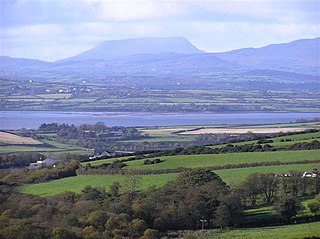
Lough Swilly in Ireland is a glacial fjord or sea inlet lying between the western side of the Inishowen Peninsula and the Fanad Peninsula, in County Donegal. Along with Carlingford Lough and Killary Harbour it is one of three glacial fjords in Ireland.


The Apprentice Boys of Derry is a Protestant fraternal society with a worldwide membership of over 10,000, founded in 1814 and based in the city of Derry, Northern Ireland. There are branches in Ulster and elsewhere in Ireland, Scotland, England, Australia and Toronto, Canada. The society aims to commemorate the 1689 Siege of Derry when Catholic James II of England and Ireland and VII of Scotland laid siege to the walled city, which was at the time a Protestant stronghold. Apprentice Boys parades once regularly led to virulent opposition from the city's Irish nationalist majority, but recently a more conciliatory approach has taken place and now the parades are virtually trouble-free. The 2014 'Shutting of the Gates' parade was described as "the biggest in years" and was violence-free.

Rear admiral Sir John Berry was an English officer of the Royal Navy.
Robert Lundy was a Scottish army officer best known for serving as Governor of Londonderry during the early stages of the Siege of Derry.
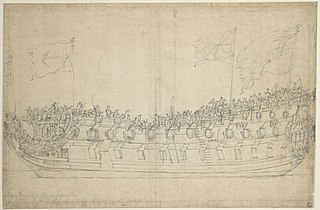
HMS Stirling Castle was a 70-gun third-rate built at Deptford Dockyard, in 1678/79. She was in active commission for the War of the English Succession, fighting in the Battles of Beachy Head and Barfleur. HMS Stirling Castle underwent a rebuild at Chatham Dockyard in 1699. She was in the Cadiz operation in 1702. The ship was wrecked on the Goodwin Sands off Deal on 27 November 1703. The remains are now a Protected Wreck managed by Historic England.
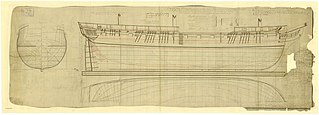
HMS Saldanha was a 36-gun Apollo-class frigate of the British Royal Navy, launched in 1809 and wrecked on the coast of Ireland in 1811. Before she was wrecked she participated in the capture of a noted French privateer.

Londonderry Port, now operating as Foyle Port, is a port located on Lough Foyle in Northern Ireland. It is the United Kingdom’s most westerly port and an important northerly port on the island of Ireland. The current port is at Lisahally, County Londonderry, though historically the port was upriver in the city of Derry itself. It is operated by the Londonderry Port and Harbour Commissioners, whose former offices, just north of the city's walls, are now a museum.
Events from the year 1689 in Ireland.
Six ships and one shore establishment of the Royal Navy have borne the name HMS Dartmouth, after the port of Dartmouth, whilst another two were planned:
HMS Restoration was a 70-gun third rate of the Kingdom of England built at Harwich Dockyard in 1677/78. After a ten-year stint in Ordinary she was commissioned for the War of the English Succession in 1690. She fought in the Battles of Beachy Head and the Battle of Barfleur. She was rebuilt at Portsmouth in 1699/1702. She was lost on the Goodwin Sands during the Great Storm of November 1703.
Gainsborough was a 40-gun fourth-rate frigate of the English Navy, originally built under the 1652 programme for the navy of the Commonwealth of England by Thomas Taylor at Pitch House (Wapping), and launched in 1653. She was named for the Parliamentarian victory at the Battle of Gainsborough in 1643.
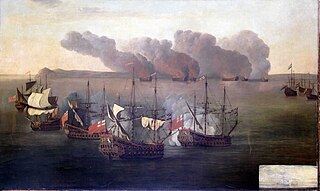
HMS Jersey was a 40-gun fourth rate frigate of the English Navy, originally built for the navy of the Commonwealth of England at Maldon, and launched in 1654. By 1677 her armament had been increased to 48 guns.
HMS Pendennis was a 70-gun third rate ship of the line of the Kingdom of England built at Chatham in 1677/79. She was in the War of English Succession. She was in the Battle of Bantry Bay. She was wrecked on the Kentish Knock in October 1689.
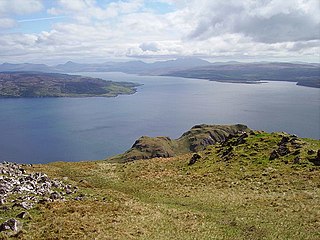
The Sound of Mull is a sound between the Inner Hebridean island of Mull and mainland Scotland. It forms part of the Atlantic Ocean.

HMS Brilliant was a 36-gun Venus-class fifth-rate frigate of the British Royal Navy that saw active service during the Seven Years' War with France. She performed well against the French Navy in the 1760 Battle of Bishops Court and the 1761 Battle of Cape Finisterre, but was less capable when deployed for bombardment duty off enemy ports. She also captured eight French privateers and sank two more during her six years at sea. The Royal Navy decommissioned Brilliant in 1763. The Navy sold her in 1776 and she became an East Indiaman for the British East India Company (EIC). Brilliant was wrecked in August 1782 on the Comoro Islands while transporting troops to India.
Numerous ships of the British Royal Navy have been named HMS Portsmouth, after the English port city and home of a naval base.

HMS Beaulieu was a 40-gun fifth-rate frigate of the Royal Navy. The ship was laid down in 1790 as a private enterprise by the shipwright Henry Adams and purchased by the Royal Navy in June of the same year. A well-armed and large ship, Beaulieu was built to the dimensions of a merchant ship and did not have good sailing qualities. Commissioned in January 1793 by Lord Northesk, the frigate was sent to serve on the Leeward Islands Station. She participated in the capture of Martinique in February 1794, and then was similarly present at the capture of Saint Lucia in April. The frigate also took part in the start of the invasion of Guadeloupe. Later in the year the ship's crew was beset by yellow fever and much depleted. Beaulieu was sent to serve on the North America Station to recuperate, returning to the Leeward Islands in 1795. In the following two years the ship found success in prizetaking and briefly took part in more operations at Saint Lucia. She returned to Britain at the end of 1796.
HMS Bredah was a 70-gun third rate ship of the line of the Kingdom of England, built at Harwich Dockyard under the 1677 Construction Programme. Her short career was fighting at Beachy Head during the War of English Succession. She was destroyed by an explosion at the Siege of Cork, Ireland in October 1690.













